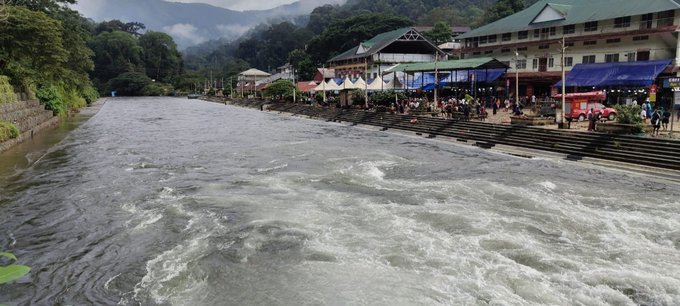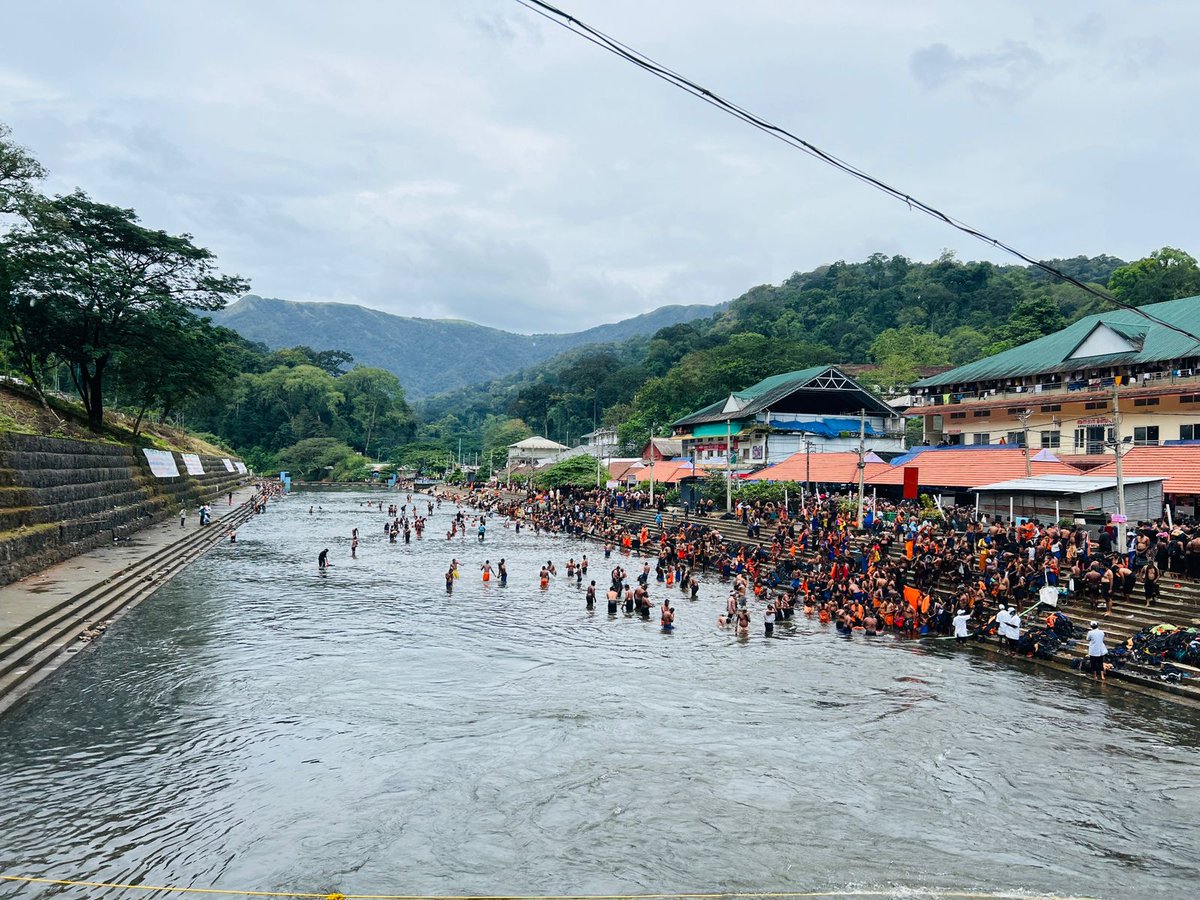ABOUT SABARIMALA
About Sabarimala
About Sabarimala
Sabarimala Sree Ayyappa Temple located at Sahyadri hills inside the Ayyappa Poongavanam, Pathanamthitta District, Keralam, India

What Makes Sabarimala Unique!
Here Bhagawan Sree Maha Vishnu in Nastika Brahmacharya Avatar.

Pathinettampadi
This temple is known for its Panch-Loha Golden 18-steps known as 'pathinettam padi' only who took brahmacharya Vratam has to climb this holy 'pathinettam padi'

One of the unique practices is (Ghee) neyi abhishekam by devotees who took brahmacharya vratam they come here with neyi(ghee) filled coconut in irumudi as offering to Bhagawan Ayyappa

The Aazhi near the 18 steps at Sabarimala Ayyappa Temple is where devotees throw coconuts. After pouring ghee from the ghee-filled coconut near the sanctum, they discard the empty shell into the Aazhi.

Pampa is sacred river also called as Dakshina Ganga,The confluence of the three rivers - Pampa, Kakki, and Njunungar - Triveni pampa is indeed a sacred spot for devotees. The traditional path to the hill shrine, which passes through Kalaketti, Azhutha, and Karimala, is a challenging yet spiritually uplifting journey for pilgrims.
The Pampa River holds great spiritual significance, and devotees consider it a privilege to take a dip in its holy waters before proceeding to the Sabarimala temple. The river's banks are also a popular spot for devotees to offer prayers, perform rituals, and seek blessings.
Sabarimala Pooja Timings
| Monthly Pooja | Time (IST) |
|---|---|
| Morning Timings | |
| Temple Opening | 3:00 AM |
| Nirmalya Darshanam | 3:05 AM |
| Ganapathi Homam | 3:30 AM |
| Neyyabhishekam | 3:45 AM - 11:00 AM |
| Usha Pooja | 7:30 AM |
| Udayasthamana Pooja | |
| Panchavadyam Kalasa Pooja | |
| Kalabham Ezhunnalathu | |
| Ucha Pooja | 12:30 PM |
| Temple Closing | 1:00 PM |
| Evening Timings | |
| Temple Opening | 3:05 PM |
| Deeparadhana | 6:30 PM |
| Pushpabhishekam | From 7:00 PM |
| Athazha Pooja | From 9:30 PM |
| Harivarasanam | From 10:50 PM |
| Temple Closing | 11:00 PM |
Special Pooja's
Neyyabhishekam
Neyyabhishekam is the most significant offering to Lord Ayyappa. This sacred ritual involves the use of a ghee-filled coconut and begins at 5:00 AM, continuing until Ucha Pooja (1:00 PM). After having darshan of Lord Ayyappa and the upa-prathistas, groups of Ayyappa pilgrims, under the guidance of a Guru Swamy (the most senior pilgrim), prepare a viri—a sheet spread on the ground—to collect and arrange the ghee-filled coconuts. Following a ritual bath at Bhasmakkulam (the pond behind the Sannidhanam), the team leader, usually the Guru Swamy, breaks the ghee-filled coconuts and collects the ghee in a vessel to offer at the Sree Kovil (sanctum sanctorum). After performing Neyyabhishekam, the priest returns a portion of the consecrated ghee to the devotee as prasadam. For those who do not bring a ghee-filled coconut, the Devaswom Board provides an option to obtain Adiyashistam Neyyu. Symbolically, the ghee represents the human soul (jeevatma), which merges with the Supreme Being (paramatma) through this sacred offering. Once the ghee is removed, the empty coconut represents the lifeless body (jadam), which is why it is subsequently offered into the Aazhi, the sacred fire pit in front of the temple.
Padi Pooja
Padi Pooja is the ceremonial worship of the eighteen holy steps (Pathinettampadi). Conducted on select days after the Pushpabhishekam (floral bathing of the idol), the ritual takes place in the evening and is performed by the Tantri, in the presence of the Melsanthi (chief priest). The elaborate hour-long ritual involves decorating the sacred steps with flowers and silk cloths, lighting traditional lamps on each step, and culminating in the Aarathi, performed by the Tantri.
Udayasthamana Pooja
The term "Udayasthamaya" means from sunrise to sunset, signifying continuous worship throughout the day. The Udayasthamana Pooja is conducted from Nirmalyam (early morning ritual) to Athazha Pooja (night pooja). In addition to the daily nithya pooja, this offering includes special Archanas and Abhishekams to seek the divine blessings of Bhagavan (the presiding deity) and fulfill devotees' wishes. Among the 18 poojas, 15 are performed before noon, along with 45 Kalasabhishekams.
Sahasrakalasam
The Sahasrakalasam is a sacred offering to Sri Dharmashastha (Hariharaputhra), performed according to Tantric Vedas and Agama Shastras. This grand ritual is conducted to invoke divine blessings for the welfare of humanity. It involves consecrating holy Kalasams (sacred pots) made of gold, silver, and copper with sacred elements such as incense, gemstones, and holy waters from the seven seas and sacred rivers.
Ulsavabali
The Ulsava Bali ritual begins with the sounding of Paani, which is believed to invite the Bhoothaganams (celestial attendants of the deity). This is followed by Ulsava Bali Thooval, where the temple Tantri sprinkles cooked raw rice over the Balikallus (sacred stones dedicated to Bhoothaganams) around the Nalambalam and Balikkalpura. Once the rice is sprinkled over the Saptha Maathrukkal (Seven Divine Mothers), the Thidambu (sacred idol) of the presiding deity is taken out of the Sanctum Sanctorum, allowing devotees to offer prayers. This ritual is an integral part of the annual festival at the Lord Ayyappa Temple.
Pushpabhishekam
Pushpabhishekam is a sacred ritual in which flowers are showered upon Lord Ayyappa at Sabarimala. The flowers and leaves used in this offering include: Tamara (Lotus)- Jamanthi (Chrysanthemum), Arali, Tulsi (Basil), Mulla (Jasmine), Kuvalam (Bilva leaves)
Ashtabhishekam
Ashtabhishekam is one of the most important offerings at Sabarimala. It involves performing eight sacred ablutions using the following substances: Vibhuti (sacred ash), Milk, Honey, Panchamrutam (a mixture of five sacred ingredients), Tender coconut water, Sandalwood paste (Chandanam), Rosewater (Panineer), Pure water (Note: The ingredients for Ashtabhishekam may vary between different Hindu temples.)
Kalabhabhishekam
Kalabhabhishekam is a highly significant special pooja performed to enhance the Chaithanya (spiritual energy) of the deity. The ritual begins with the Tantri conducting the Kalabhakalasa Pooja at the Nalambalam, in the presence of the Melsanthi. The final phase, Kalabhakalasabhishekam, involves the pouring of sandalwood paste over the idol of Lord Ayyappa. This occurs during the Ucha Pooja, following a grand procession carrying a golden urn filled with sandalwood paste around the Sree Kovil.
Laksharchana
The term "Laksharchana" is derived from "Laksha" (100,000) and "Archana" (chanting and glorifying the divine name). This sacred practice involves the collective recitation of Lord Ayyappa's name in the form of a Mantra. The Tantri, assisted by the Melsanthi and other priests, conducts the Laksharchana at the Sannidhanam. The concluding ritual, known as Brahmakalasam, is then taken in procession to the Sanctum Sanctorum, where it is offered as an Abhishekam before the Ucha Pooja.
Upadevathas
Malikapurathamma
Maalikapurathamma (Lalithambika) is the goddess who is worshipped in a subsidiary shrine at Sabarimala Sree Ayyappa Temple.

Malamandapam
Mala warrior

Kochu Kadutha Swami
The shrine of kochu kadutha swami is located in front of the Malamandapam near the Malikapurathamma.

Valiya Kadutha Swami
The shrine of Valiya Kadutha is located on the Right side of holy pathinettam padi.

JAYANATHAN AND MAYA DEVI
Parents of Bhagwan Ayyappa
The temple of is located on the left side of the Pathinettam Padi, Now Portraying as Karuppa and Karuppai amma

Trek Routes
Trek to Sabarimala
Route 1: Pampa to Sannidhanam known as Neelimala Road, approximate Distance 3.30km, approximate time 1-2hrs.
• Timings: 24 Hours
• Spot Booking Centre: Nilakkal
• Parking: Nilakkal OR PAMPA

Route 2: Pampa to Sannidhanam known as Swami Ayyappan Road, approximate Distance 3.75km, approximate time 1-2hrs.
• Timings: 24 Hours
• Spot Booking Centre: Nilakkal
• Parking: Nilakkal OR PAMPA

Route 3: Erumeli-Azhuthakadavu-Pampa known as Traditional Route, approximate Distance 24.25km, approximate time 8-9hrs.
• Timings: Azhuthakadavu Entry Time: 7AM-2:30PM
MUKKUZHY Entry Time: 7AM-3PM
• Parking: ERUMELI
• Spot Booking Centre: Nilakkal

Route 4: Sathram-Pullumedu-Sabarimala, approximate Distance 12km, approximate time 3-4hrs.
• Timings: Sathram Entry Time: 7AM-12PM
• Parking: Sathram
• Spot Booking Centre: VANDIPERIYAR OR SATHRAM

Route 5: Sabarimala-Pullumedu-Sathram, approximate Distance 12km, approximate time 3-4hrs.
• Timings: SABARIMALA(URUKKUZHI) Towards Sathram Entry Time: 8AM-11AM

Chant

"Sri Kovil Thurannu" (more popularly known as "Sreekovil Nada Thurannu") is a cherished Malayalam devotional song that announces the opening of the sanctum sanctorum, inviting devotees for darshan after rituals or pujas.
This devotional gem was written by Kaippally Krishna Pillai, composed and sung by the musical duo Jaya-Vijaya, and was first released in 1976.
Sreekovil nada thurannu
Ponnambalathil sreekovil nada thurannu
Shankaranathan kaavadiyetthu vannu
Thangapathaaka ketti thiruvaabharanavum
Velichamaniyichche deepaaradhanayum
Sreekovil nada thurannu
Ponnambalathil sreekovil nada thurannu
Sankrama sandhyaa sindooram chaarthiya
Ponnambalaththin sreekovil nada thurannu
Deepaavaliyum unarnnu
Sharana vili uyarnnu
Swamiye Sharanamayyappa
Janakodikalude yuga saadhanayude
Asulabha nirvrithi thaaraniyunnu
Atiloru neriyaparaagarenuvil
Alinju cheranathimoham
Thozhukayyode mizhinneerode
Thirusannidhiyil njan ninnotte
Sharanaa, karunaalayaney
Sharanam neeye Sabarigirisha
"Harivarasanam", also known as "Hariharatmaja Ashtakam", is a sacred lullaby sung at the Sabarimala temple before the sanctum closes at night. It is deeply revered by Ayyappa devotees across the world.
Harivarasanam Viswamohanam
Haridadhiswaram Aaradhyapadhukam
Arivimardhanam Nithyanarthanam
Hariharathmajam Devamashraye
Saranakirtanam Bhaktamanasam
Bharanalolupam Narthanalasam
Arunabhasuram Bhoothanayakam
Hariharathmajam Devamashraye
Pranayasathyakam Praananayakam
Pranathakalpakam Suprabhanjitham
Pranavamanidram Keerthanapriyam
Hariharathmajam Devamashraye
Thuragavahanam Sundarananam
Varagadhayudham Vedavavarnitham
Gurukrupakaram Keerthanapriyam
Hariharathmajam Devamashraye
Tribhuvanarchitham Devathathmakam
Trinayanam Prabhum Divyadeshikam
Tridashapoojitham Chinthithapradam
Hariharathmajam Devamashraye
Bhavabhayapaham Bhavukavaham
Bhuvanamohanam Bhoothibhooshanam
Dhavalavahanam Divyavaranam
Hariharathmajam Devamashraye
Kalamrudusmitham Sundarananam
Kalabhakomalam Gathramohanam
Kalabhakesari Vajivahanam
Hariharathmajam Devamashraye
Srithajanapriyam Chinthithapradam
Sruthivibhushanam Sadhujeevanam
Sruthimanoharam Geethalalasam
Hariharathmajam Devamashraye
